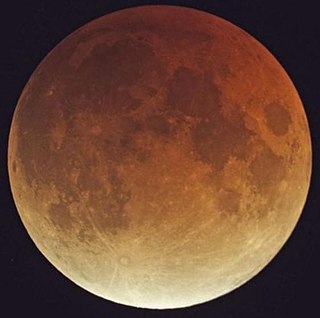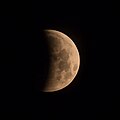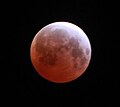
A total solar eclipse occurred on March 29, 2006. A solar eclipse occurs when the Moon passes between Earth and the Sun, thereby totally or partly obscuring the image of the Sun for a viewer on Earth. A total solar eclipse occurs when the Moon's apparent diameter is larger than the Sun's, blocking all direct sunlight, turning day into darkness. Totality occurs in a narrow path across Earth's surface, with the partial solar eclipse visible over a surrounding region thousands of kilometres wide. It was visible from a narrow corridor which traversed half the Earth. The magnitude, that is, the ratio between the apparent sizes of the Moon and that of the Sun, was 1.052, and it was part of Saros 139.

A total lunar eclipse took place on 3 March 2007, the first of two eclipses in 2007. The Moon entered the penumbral shadow at 20:18 UTC, and the umbral shadow at 21:30 UTC. The total phase lasted between 22:44 UTC and 23:58 UTC with a distinctive brick-red shade. The Moon left the umbra shadow at 01:11 UTC and left the penumbra shadow at 02:24 UTC 2007-03-04. The second lunar eclipse of 2007 occurred on 28 August.

A total lunar eclipse occurred on February 20 and February 21, 2008. It was visible in the eastern evening sky on February 20 for all of North and South America, and on February 21 in the predawn western sky from most of Africa and Europe. Greatest Eclipse occurring on Thursday, February 21, 2008, at 03:26:03 UTC, totality lasting 49 minutes and 45.6 seconds.

A total lunar eclipse took place on Friday, May 16, 2003, the first of two total lunar eclipses in 2003, the other being on November 9, 2003. A shallow total eclipse saw the Moon in relative darkness for 52 minutes and 3.1 seconds. The Moon was 12.938% of its diameter into the Earth's umbral shadow, and should have been significantly darkened. The partial eclipse lasted for 3 hours, 15 minutes and 3.1 seconds in total. Occurring only 0.5 days after perigee, the Moon's apparent diameter was 6.2% larger than average. At greatest eclipse the Moon was only 357,693 km from the Earth, making it a Super Full Moon.

A partial lunar eclipse took place on Monday, March 24, 1997, the first of two lunar eclipses in 1997.

A partial lunar eclipse took place on 25 April 2013, the first of three lunar eclipses in 2013. Only a tiny sliver (1.48%) of the Moon was covered by the Earth's umbral shadow at maximum eclipse, but the entire northern half of the Moon was darkened from being inside the penumbral shadow. This was one of the shortest partial eclipses of the Moon for the 21st century, lasting 27 minutes. This was the last of 58 umbral lunar eclipses of Lunar Saros 112.

A total lunar eclipse took place on 15 April 2014. It was the first of two total lunar eclipses in 2014, and the first in a tetrad. Subsequent eclipses in the tetrad are those of 8 October 2014, 4 April 2015, and 28 September 2015. Occurring 6.7 days after apogee, the Moon's apparent diameter was smaller.

A total lunar eclipse took place on Wednesday 8 October 2014. It is the second of two total lunar eclipses in 2014, and the second in a tetrad. Other eclipses in the tetrad are those of 15 April 2014, 4 April 2015, and 28 September 2015. Occurring only 2.1 days after perigee, the Moon's apparent diameter was larger, 1960.6 arcseconds.

A total lunar eclipse took place between 27 and 28 September 2015. It was seen on Sunday evening, 27 September, in the Americas; while in Europe, Africa, and the Middle East, it was seen in the early hours of Monday morning, 28 September. It was the latter of two total lunar eclipses in 2015, and the final in a tetrad. Other eclipses in the tetrad are those of 15 April 2014, 8 October 2014, and 4 April 2015.

A total lunar eclipse occurred at the Moon's descending node on 27 July 2018. The Moon passed through the center of Earth's shadow in what was the first central lunar eclipse since 15 June 2011. It was also the second total lunar eclipse in 2018, after the one on 31 January. It was the longest total lunar eclipse of the 21st century, but not the longest in the 3rd millennium. The longest total lunar eclipse of the 3rd millennium will occur on May 12, 2264, lasting 106 minutes and 13.2 seconds, which will be the longest total lunar eclipse since 2000, and the longest one until 3107.

A total lunar eclipse will take place on July 7, 2047. It will last 1 hour 40 minutes and 49 seconds and will plunge the full Moon into deep darkness, as it passes right through the centre of the Earth's umbral shadow. While the visual effect of a total eclipse is variable, the Moon may be stained a deep orange or red colour at maximum eclipse. This will be a great spectacle for everyone who sees it. The partial eclipse will last for 3 hours and 39 minutes in total.
A total lunar eclipse took place at the Moon's descending node of the orbit on Wednesday, February 10, 1971, the first of two total lunar eclipses in 1971. It had an umbral magnitude of 1.30819. The Moon passed through the center of the Earth's shadow. The Moon was plunged into darkness for 1 hour, 22 minutes and 11.4 seconds, in a deep total eclipse which saw the Moon 30.819% of its diameter inside the Earth's umbral shadow. The visual effect of this depends on the state of the Earth's atmosphere, but the Moon may have been stained a deep red colour. The partial eclipse lasted for 3 hours, 44 minutes and 42.9 seconds and in total. Occurring only 2.7 days before apogee, the Moon's apparent diameter was 5.9% smaller than average.
A partial lunar eclipse took place on Saturday, June 25, 1983, the first of two lunar eclipses in 1983 with an umbral eclipse magnitude of 0.33479. A partial lunar eclipse happens when the Earth moves between the Sun and the Full Moon, but they are not precisely aligned. Only part of the Moon's visible surface moves into the dark part of the Earth's shadow. A partial lunar eclipse occurs when the Earth moves between the Sun and Moon but the three celestial bodies do not form a straight line in space. When that happens, a small part of the Moon's surface is covered by the darkest, central part of the Earth's shadow, called the umbra. The rest of the Moon is covered by the outer part of the Earth's shadow called the penumbra. The Earth's shadow on the moon was clearly visible in this eclipse, with 33% of the Moon in shadow; the partial eclipse lasted for 2 hours and 15 minutes.
A penumbral lunar eclipse took place on Thursday, March 3, 1988, the first of two lunar eclipses in 1988, the second being on August 27, 1988. Earlier sources compute this as a 0.3% partial eclipse lasting under 14 minutes, and newest calculations list it as a penumbral eclipse that never enters the umbral shadow. In a rare total penumbral eclipse, the entire Moon was partially shaded by the Earth, and the shading across the Moon should have been quite visible at maximum eclipse. The penumbral phase lasted for 4 hours, 53 minutes and 50.6 seconds in all, though for most of it, the eclipse was extremely difficult or impossible to see. The Moon was 2.2 days after apogee, making it 6.1% smaller than average.

A partial lunar eclipse occurred on 19 November 2021. The eclipse occurred towards a micromoon. This was the longest partial lunar eclipse since 18 February 1440, and the longest until 8 February, 2669; however, many eclipses, including the November 2022 lunar eclipse, have a longer period of umbral contact at next to 3 hours 40 minutes. It was often referred to as a "Beaver Blood Moon" although not technically fulfilling the criteria for a true blood moon (totality).

A partial lunar eclipse will take place on Friday 28 August 2026. The moon will be almost be inside the umbra, but not quite be contained within the umbral shadow at greatest eclipse.
A total lunar eclipse took place on Sunday, January 30, 1972, the first of two lunar eclipses in 1972. The moon entered the Earth's penumbral shadow at 30 January 1972 08:03:12.5 UTC and exited at 30 January 1972 13:43:37.9 UTC. The moon entered the Earth's umbral shadow at 30 January 1972 09:11:38.4 UTC and exited at 30 January 1972 12:35:03.1 UTC. Totality lasted 34 minutes, 47.7 seconds, between 10:35:57.4 UTC and 11:10:45.1 UTC. The moon was 6.6 days before apogee, making it 1.6% smaller than average, only 0.2% larger than the July 1972's lunar eclipse.

A total lunar eclipse took place on Monday, April 24, 1967, the first of two total lunar eclipses in 1967, the second being on October 18, 1967.

A total penumbral lunar eclipse is a lunar eclipse that occurs when the Moon becomes completely immersed in the penumbral cone of the Earth without touching the umbra.

A total lunar eclipse will take place on April 26, 2051.

































































































